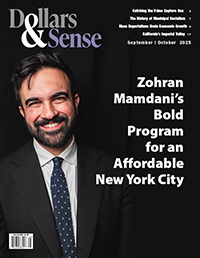Economists, the Trump Tariffs, and Alternatives
One should not jump from the condemnation of Trump’s tariffs by economists (and others) to an acceptance of free trade as a key to economic progress.

New York Democratic mayoral nominee Zohran Mamdani has drawn both praise and sneers for his free bus proposal. As detailed in Nick French’s article in this issue (p. 11), a Mamdani-backed program that piloted five free bus lines in 2023–2024 succeeded in dramatically increasing ridership and lowering assaults on drivers. Extending free buses to the whole city would cost some $800 million, less than half of 1% of New York City’s budget.

Mamdani’s proposal has proved so popular that one of his opponents, Andrew Cuomo, has jumped in with his own “free” New York City transit program, including subways. His program, however, wouldn’t actually provide all New Yorkers with free transit—the plan would only benefit New Yorkers earning up to 150% of the federal poverty level. Cuomo is even accusing Mamdani of wanting to subsidize the rich by making all bus fares free for everyone.
This is ironic, because in 2018, while he was still governor, Cuomo proposed a truly progressive system of financing transit: value capture. Property owners near transit stops benefit from bus and subway service in the form of higher property values. In 2017, two professors at New York University estimated that being near a subway adds $3.85 per square foot to the value of commercial property, including apartment buildings. For public transit or other public services, value capture means taxing nearby property to return that value to the public treasury. Cuomo proposed authorizing the MTA to establish “transit improvement subdistricts” and impose such taxes.
Value capture is a very old idea, and it’s popular among city planners. For example, some 30 years ago, the New York City Parks Commissioner Henry Stern proposed supporting parks with taxes on nearby property—a proposal I enthusiastically supported as an owner of a small rental building close to still-rundown Central Park. Amid howls from the real estate industry, the commissioner hastily backed down. Likewise, Cuomo’s 2018 efforts went nowhere. However, unlike Cuomo, Mamdani is already targeted by big real estate. He has nothing to lose from proposing a tax on properties near bus stops to cover the $800 million cost of free bus fares.
But why stop there? All property taxes capture value—the value of public services, including roads and utilities, police and firefighters, health care and schools—and the spillover value of private investment in housing and businesses. The synergy between public and private values creates towering spikes in central-city property values. Property ownership is wealth, including indirect property ownership through corporate stocks and bonds. Wealth is orders of magnitude more concentrated than income (see sidebar).
That makes property taxes the most intrinsically progressive tax we have. In 2024, 44% of New York City’s tax revenue came from property taxes; the percent used to be much higher.
Mamdani proposes to pay for new affordable housing, childcare, cheap groceries, and other public services by raising income taxes on rich New Yorkers and corporations. It’s a nice idea, but it requires the cooperation of the state legislature, which isn’t assured. Moreover, to avoid taxes, rich city residents can claim a home address at their summer pad on Martha’s Vineyard and corporations can claim headquarters in Ireland. But they can’t hide one square foot of their New York City property.
Why not increase property tax rates instead, or in addition to, income tax rates?
Property taxes have two components: an assessment—the estimated market value of a property—and the tax rate which is applied to the assessment. Assessments tend to lag way behind the actual market value of the property, usually to the benefit of large, influential property owners. Albany constrains assessments, limiting the fraction of market value for different property classes and the rate at which assessments can increase—again, to the benefit of more valuable properties. But the city still administers the assessment process. And crucially, the New York City Council sets the tax rate.
To his great credit, Mamdani has already promised to fix biased property assessments. He should also persuade the City Council to increase tax rates. This strategy is at least as feasible as going to Albany for income tax increases. Mamdani needs to catch the value capture bus.
Polly Cleveland is an economist specializing in land use and inequality. She is also a member of the Dollars & Sense board.
Sources: “Property tax bills and payments,” New York City Department of Finance (nyc.gov/site/finance/property/property-bills-and-payments.page); “Wealth Inequality in the United States,” Inequality.org (inequality.org/facts/wealth-inequality); “Income Inequality in the United States,” Inequality.org (inequality.org/facts/income-inequality); “Inequality and Taxes,” Inequality.org (inequality.org/facts/taxes-inequality-in-united-states); Elizabeth Kim, “Looking to One-up Zohran Mamdani, Cuomo Unveils Free NYC Transit Plan,” Gothamist, August 7, 2025 (gothamist.com); Stephanos Chen, “Mamdani’s Win has Put Buses in the Spotlight: Should They Be Free?” New York Times, July 3, 2025 (nytimes.com); James Barron, “The Subway Next Door: Should New Yorkers Pay Extra for That?” New York Times, January 29, 2018 (nytimes.com); Christine Lee, “Professors: Landlords Must Pay MTA,” Washington Square News, November 27, 2017 (nyunews.com), Edward N. Wolff, “Household Wealth Trends in the United States, 1962 to 2019: Median Wealth Rebounds ... but Not Enough,” National Bureau of Economic Research Working Paper Series, January 2021 (nber.org).